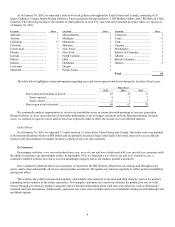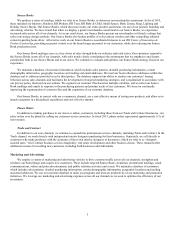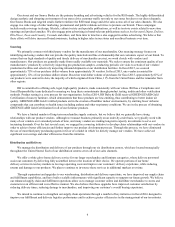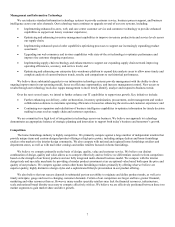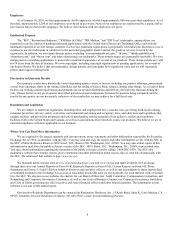Restoration Hardware 2015 Annual Report Download - page 17
Download and view the complete annual report
Please find page 17 of the 2015 Restoration Hardware annual report below. You can navigate through the pages in the report by either clicking on the pages listed below, or by using the keyword search tool below to find specific information within the annual report.
14
In addition, there is a risk that compliance lapses by our vendors could occur, which could lead to investigations by U.S.
government agencies responsible for international trade compliance. Any resulting penalty or enforcement action could delay future
imports/exports or otherwise negatively impact our business. In addition, there can be no assurance that our vendors outside the
United States will adhere to applicable legal requirements or our global compliance standards such as fair labor standards, prohibitions
on child labor and other product safety or manufacturing safety standards. The violation of applicable legal requirements by any of our
vendors or the failure to adhere to labor, manufacturing safety and other laws by any of our vendors, or the divergence of the labor
practices followed by any of our vendors from those generally accepted in the United States, could disrupt our supply of products from
our vendors or the shipment of products to us, result in potential liability to us and harm our reputation and brand and subject us to
boycotts by our customers or activist groups, any of which could negatively affect our business and results of operations.
Our growth strategy and performance depend on our ability to purchase quality merchandise in sufficient quantities at competitive
prices, including products that are produced by artisans and specialty vendors. Any disruptions we experience in our ability to
obtain quality products in a timely fashion or in the quantities required could have a material adverse effect on our business.
We purchase substantially all of our merchandise from a number of third party vendors. Many such vendors are the sole sources
for particular products, and we generally transact business with such vendors on an order-by-order basis without any long-term or
other contractual assurances of continued supply, pricing or access to new products with our vendors. Therefore, we may be dependent
on particular vendors that produce popular items, and any vendor could discontinue selling to us at any time. In the event that one or
more of our vendors is unable or unwilling to meet the quantity or quality of our product requirements, we may not be able to develop
relationships with new vendors in a manner that is sufficient to supply the shortfall. Even if we do identify such new vendors, we may
experience product shortages and customer backorders as we transition our product requirements to incorporate alternative suppliers.
Our relationship with any new vendor would be subject to the same or similar risks as those of our existing suppliers.
Furthermore, our growth strategy includes expanding our product assortment, and our performance depends on our ability to
purchase our merchandise in sufficient quantities at competitive prices. However, many of our key products are produced by artisans,
specialty vendors and other vendors that are small, undercapitalized or that may have limited production capacity, and we have from
time to time in prior periods experienced supply constraints that have affected our ability to supply high demand items or new
products due to such capacity and other limits in our vendor base.
A number of our vendors, particularly our artisan vendors, may have limited financial or other resources and operating histories
and may receive various forms of credit from us, including with respect to payment terms or other arrangements. In some cases, we
have advanced payments to vendors in order to assist a vendor in funding additional merchandise production to meet our orders. We
may advance a portion of the payments to be made to some vendors under our purchase orders prior to the delivery of the ordered
products. These advance payments are normally unsecured. Vendors may become insolvent and their failure to repay our advances,
and any failure to deliver products to us, could have a material adverse impact on our results of operations. There can be no assurance
that the capacity of any particular vendor will continue to be able to meet our supply requirements in the future, as our vendors may be
susceptible to production difficulties or other factors that negatively affect the quantity or quality of their production during future
periods. A disruption in the ability of our significant vendors to access liquidity could also cause serious disruptions or an overall
deterioration of their businesses, which could lead to a significant reduction in their ability to manufacture or ship products to us. Any
difficulties that we experience in our ability to obtain products in sufficient quality and quantity from our vendors could have a
material adverse effect on our business.
Our vendors may sell similar or identical products to our competitors or on their own, which could harm our business.
Because the arrangements with our vendors are generally not exclusive, many of our vendors might be able to sell similar or
identical products to our competitors. Our competitors may enter into arrangements with suppliers that could impair our ability to sell
those suppliers’ products, including by requiring suppliers to enter into exclusive arrangements, which could limit our ability to enter
into arrangements with such suppliers or otherwise access their products. Such competitors may also purchase products in
significantly greater volume that we do, which may enable them to sell the products at reduced cost or flood the market with similar
products.
Our vendors could also initiate or expand sales of their products through vendor-owned stores or through the Internet to the
retail market and therefore directly compete with us or sell their products through outlet centers or discount stores, increasing the
competitive pricing pressure we face.
Any of the above factors could negatively affect our business and results of operations.


